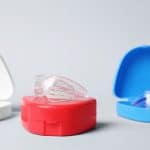Some people swear by the fresh feeling flossing gives them, while others absolutely hate the idea of threading a piece of string between their teeth. Flossing has its staunch supporters and detractors. But does it really make a difference? Let’s settle this debate once and for all.
Removing food particles
Flossing is crucial for maintaining good oral hygiene. It helps remove food particles from areas your toothbrush can’t reach effectively. Additionally, flossing removes plaque between your teeth, helping to prevent gum inflammation. However, it can also be painful and time-consuming. Read on for more details.
If you’re going to floss, do it right
The issue with flossing is that many people don’t do it correctly. Instead of removing plaque, they often just push it further into the gums. Many even end up damaging their gums, which can do more harm than good!
How to floss properly
- Guide the floss gently into the space between your teeth.
- Pull the floss softly under the gumline.
- Move the floss back and forth between your teeth, from the inside out.
- It’s crucial to handle the floss gently to avoid gum damage.
Stick with it
If you’re not used to flossing daily, your gums might bleed initially. But with regular flossing, the bleeding should stop over time.
Some alternatives to consider
Can’t quite get the hang of flossing? It might be better to brush thoroughly with a soft toothbrush and use a special interdental brush designed to clean between your teeth. These small brushes are a convenient alternative to traditional floss. Remember to rinse well afterward.
Conclusion: good oral hygiene Is essential
Flossing is a key part of maintaining it. However, it’s important to floss correctly or use an interdental brush to ensure you’re truly benefiting your oral health.







